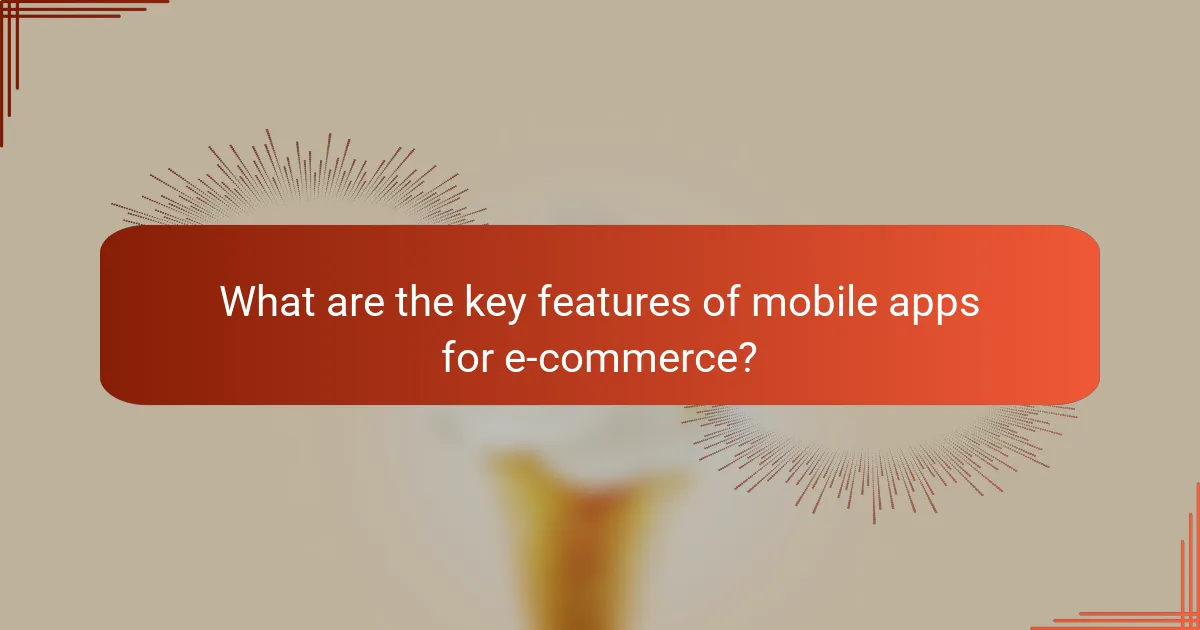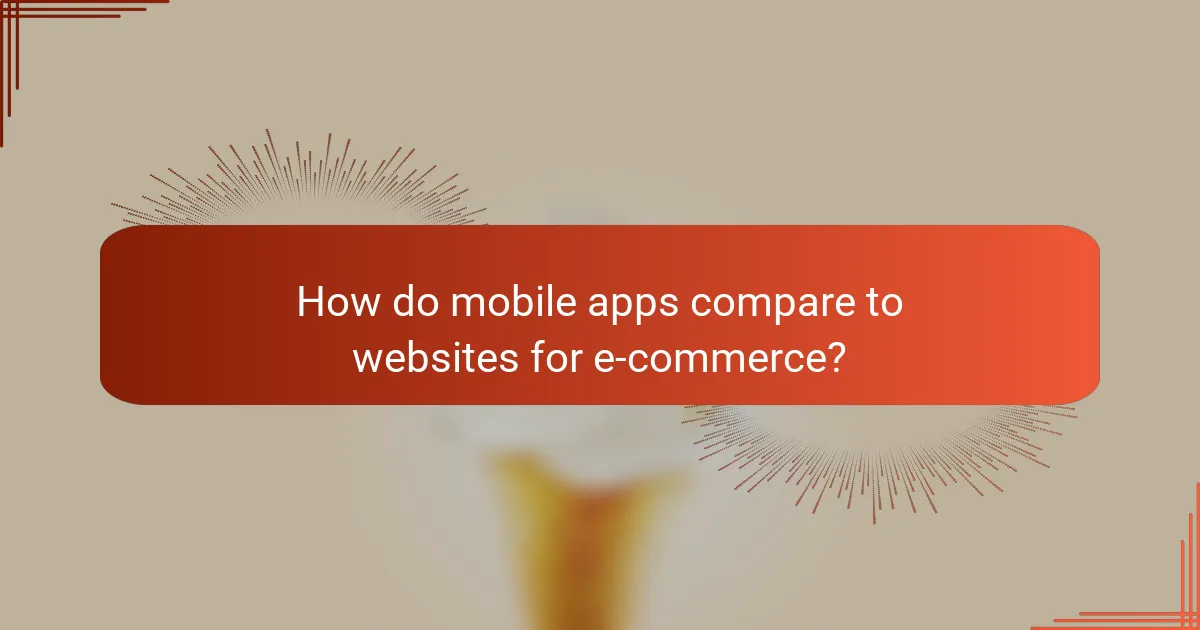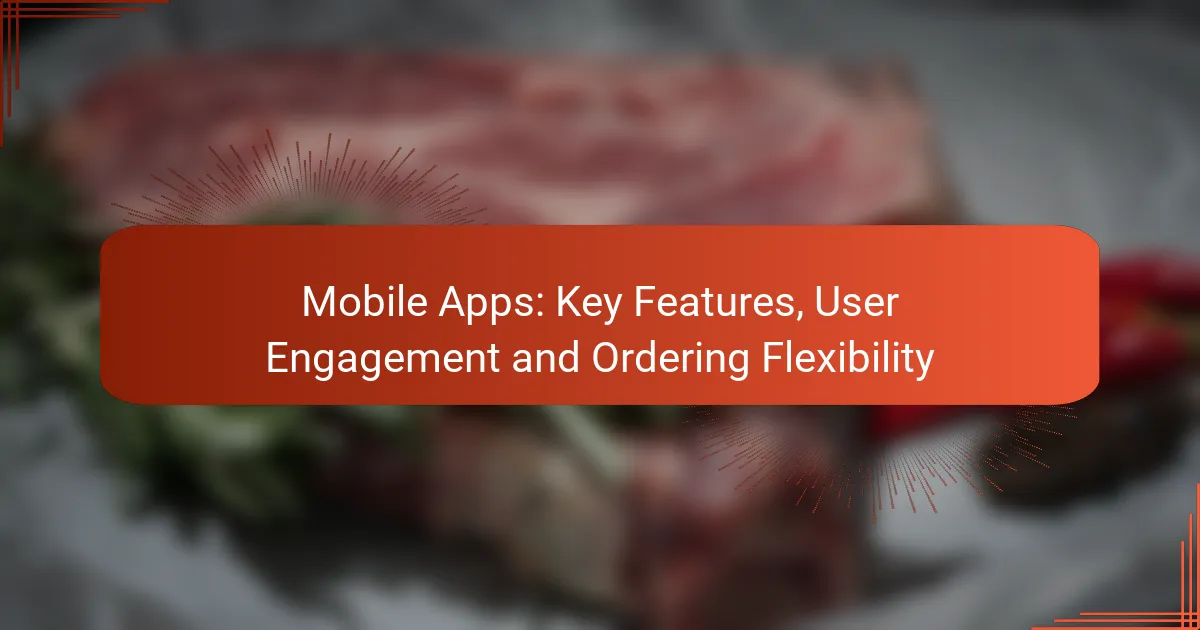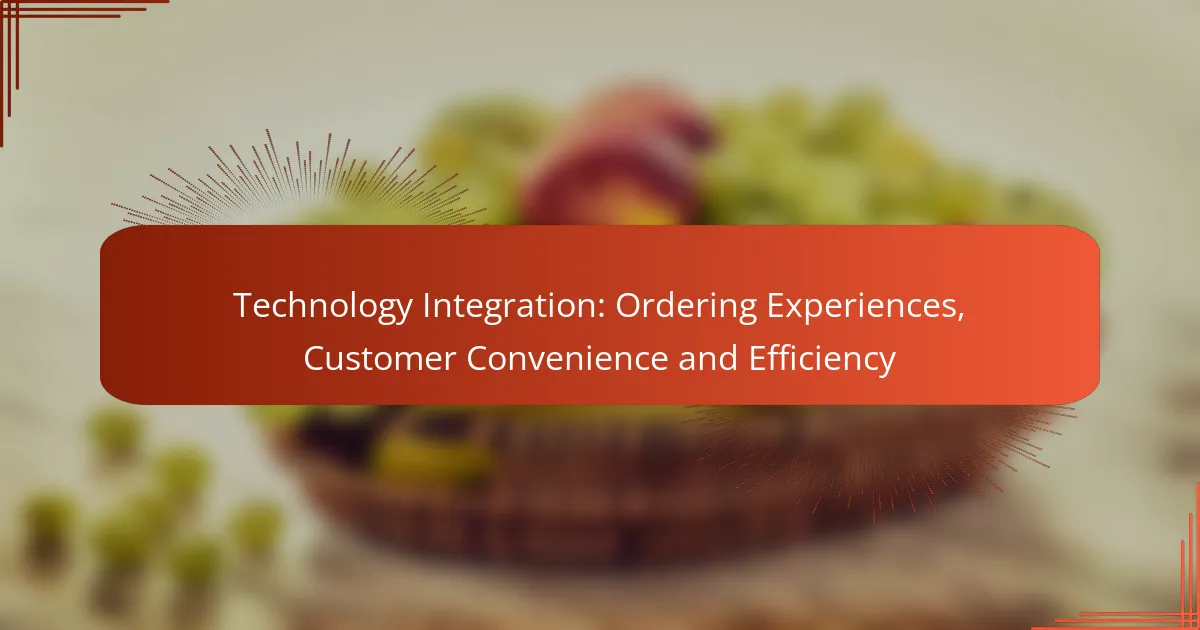Mobile apps for e-commerce are pivotal in transforming the shopping experience by integrating essential features that boost user engagement and simplify transactions. With user-friendly interfaces, personalization options, and secure payment gateways, these apps not only enhance interaction but also provide significant ordering flexibility, allowing customers to tailor their purchasing experience to their preferences.

What are the key features of mobile apps for e-commerce?
Mobile apps for e-commerce are designed to enhance the shopping experience by providing essential features that facilitate user engagement and streamline transactions. Key features include user-friendly interfaces, personalization options, secure payment gateways, push notifications, and effective product catalog management.
User-friendly interface
A user-friendly interface is crucial for e-commerce mobile apps as it directly impacts user engagement and satisfaction. Intuitive navigation, clear categorization of products, and visually appealing design help users find what they need quickly. Consider implementing a simple layout with easy access to essential functions like search, cart, and account management.
To enhance usability, ensure that buttons are large enough for touch interactions and that the app is responsive across various devices. Testing with real users can provide valuable insights into potential improvements.
Personalization options
Personalization options allow e-commerce apps to tailor the shopping experience to individual users, increasing engagement and conversion rates. This can include personalized product recommendations based on browsing history, tailored promotions, and customized content that resonates with user preferences.
Utilizing data analytics and machine learning algorithms can help in delivering relevant suggestions. However, be mindful of user privacy and ensure compliance with regulations like GDPR when collecting and using personal data.
Secure payment gateways
Secure payment gateways are essential for building trust and ensuring safe transactions in e-commerce mobile apps. Implementing well-known payment processors like PayPal, Stripe, or local options can enhance security and user confidence. Look for gateways that offer encryption and fraud detection features.
It’s important to provide multiple payment options, including credit cards, digital wallets, and bank transfers, to accommodate different user preferences. Always ensure that your app complies with PCI DSS standards to protect sensitive payment information.
Push notifications
Push notifications are a powerful tool for engaging users and driving sales in e-commerce mobile apps. They can be used to inform users about new products, special promotions, or reminders about items left in their cart. Effective use of push notifications can significantly increase user retention and conversion rates.
However, it’s crucial to strike a balance; excessive notifications can lead to user annoyance and app uninstalls. Consider segmenting your audience and personalizing notifications to enhance relevance and effectiveness.
Product catalog management
Effective product catalog management is vital for e-commerce mobile apps as it ensures that users have access to accurate and up-to-date product information. This includes managing product descriptions, images, pricing, and inventory levels. A well-organized catalog enhances the shopping experience and reduces the likelihood of customer dissatisfaction.
Utilizing a robust content management system can streamline the process of updating and maintaining the product catalog. Regular audits and updates are essential to ensure that all information is current and reflects any changes in stock or pricing.

How do mobile apps enhance user engagement?
Mobile apps enhance user engagement by providing interactive features that encourage users to interact more frequently and meaningfully. These features create a personalized experience, making users feel more connected to the brand and increasing their likelihood of returning.
Gamification elements
Gamification incorporates game-like features into mobile apps to motivate users. Elements such as points, badges, and leaderboards can make tasks more enjoyable and encourage users to complete actions, such as making purchases or sharing content.
For example, a fitness app might reward users with points for completing workouts, which can be redeemed for discounts on products. This not only boosts engagement but also fosters a sense of community among users.
Social media integration
Integrating social media into mobile apps allows users to share their experiences and achievements easily. This feature can enhance user engagement by creating a sense of community and encouraging users to invite friends to join.
For instance, a food delivery app might allow users to share their favorite meals on platforms like Instagram or Facebook, increasing visibility and attracting new users. This not only engages current users but also serves as a marketing tool.
Customer feedback mechanisms
Customer feedback mechanisms enable users to provide input on their experiences, which can enhance engagement. Features such as ratings, reviews, and surveys allow users to feel heard and valued.
For example, an e-commerce app might prompt users to rate their shopping experience after a purchase. This feedback can be used to improve the app and address user concerns, fostering loyalty and repeat visits.
Loyalty programs
Loyalty programs reward users for their continued engagement with the app, encouraging repeat usage. These programs often offer points or discounts based on user activity, making users feel appreciated.
A coffee shop app might offer a free drink after a certain number of purchases, incentivizing users to choose that shop over competitors. This not only boosts engagement but also builds long-term customer relationships.

What ordering flexibility do mobile apps provide?
Mobile apps offer significant ordering flexibility by allowing users to customize their purchasing experience through various features. This flexibility enhances user satisfaction and streamlines the ordering process, making it easier for customers to choose how and when they want to receive their products or services.
Multiple payment options
Mobile apps typically support a range of payment methods, including credit and debit cards, digital wallets, and even bank transfers. This variety allows users to select their preferred payment method, which can lead to higher conversion rates and customer loyalty.
For example, apps may integrate with popular services like PayPal, Apple Pay, or Google Pay, enabling quick and secure transactions. Offering multiple payment options also caters to different user preferences and increases the likelihood of completing a purchase.
Order tracking features
Order tracking features in mobile apps provide users with real-time updates on their purchases, enhancing transparency and trust. Customers can monitor their order status from confirmation to delivery, which reduces anxiety and improves the overall experience.
Many apps include notifications via push alerts or SMS, informing users of key milestones such as when their order is being prepared, shipped, or out for delivery. This feature not only keeps customers informed but also encourages repeat business by fostering a sense of reliability.
Scheduled delivery options
Scheduled delivery options allow users to select a specific time for their orders to arrive, accommodating their personal schedules. This feature is particularly beneficial for services like food delivery or grocery shopping, where timing can be crucial.
Customers can often choose from available time slots during the checkout process, ensuring that deliveries align with their availability. Implementing this feature can significantly enhance user satisfaction, as it provides convenience and flexibility in managing their orders.

What are the prerequisites for developing a successful e-commerce mobile app?
To develop a successful e-commerce mobile app, it is essential to conduct thorough market research, understand your target audience, and establish the necessary technical requirements. These steps lay the foundation for creating an app that meets user needs and stands out in a competitive landscape.
Market research
Market research involves analyzing current trends, competitor offerings, and consumer behaviors within the e-commerce space. This process helps identify gaps in the market and potential opportunities for differentiation. Utilize surveys, focus groups, and industry reports to gather relevant data.
Consider examining both local and global markets to understand varying consumer preferences. For instance, while mobile shopping is prevalent in many regions, payment methods and user interface preferences can differ significantly across countries.
Target audience analysis
Understanding your target audience is crucial for tailoring your app to meet their specific needs. Create user personas that represent different segments of your audience, including demographics, shopping habits, and pain points. This will guide your design and feature decisions.
Engage with potential users through interviews and feedback sessions to gain insights into their expectations. For example, if your audience values quick checkout processes, prioritize streamlining that feature in your app.
Technical requirements
Establishing technical requirements involves selecting the right platform, programming languages, and tools for app development. Decide whether to build a native app for iOS and Android or a cross-platform solution based on your budget and target audience.
Additionally, ensure compliance with relevant regulations, such as data protection laws, which can vary by region. Implementing secure payment gateways and robust security measures is essential to protect user data and build trust.

How do mobile apps compare to websites for e-commerce?
Mobile apps generally offer a more streamlined and efficient experience for e-commerce compared to websites. They provide faster performance, higher user retention, and improved conversion rates, making them a preferred choice for many businesses.
Performance speed
Mobile apps typically load faster than websites, often achieving response times in the low tens of milliseconds. This speed is crucial for e-commerce, as delays can lead to abandoned carts and lost sales.
To enhance performance, developers should optimize app size and leverage caching techniques. Regular updates and maintenance can also help maintain speed and responsiveness.
User retention rates
User retention rates for mobile apps tend to be significantly higher than for websites, often exceeding 20% within the first month. This is largely due to the personalized experience and push notifications that apps can offer.
To improve retention, businesses should focus on creating engaging content and features that encourage users to return. Implementing loyalty programs or exclusive in-app offers can also boost user loyalty.
Conversion rates
Mobile apps often achieve higher conversion rates compared to websites, with some studies indicating rates up to 50% higher. This is attributed to the ease of use and simplified checkout processes that apps provide.
To maximize conversion, ensure that the app has a user-friendly interface and a seamless payment system. Regularly analyzing user behavior can help identify areas for improvement in the purchasing process.



